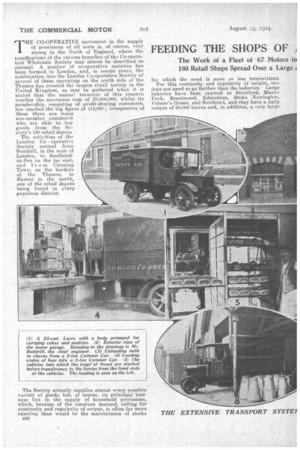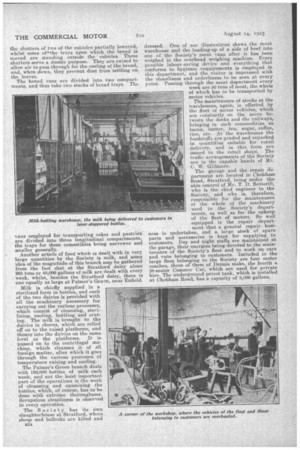FEEDING THE SHOPS OF G COOPERATIVE SOCIETY.
Page 16

Page 17

Page 18

If you've noticed an error in this article please click here to report it so we can fix it.
The Work of a Fleet of 67 Motors in 180 Retail Shops Spread Over a Large z mg Foodstuffs and Delivering Them to ulous Area in London and Its Suburbs.
THE CO-OPERATIVE movement in the supply of provisions of all sorts is, of course, very strong in the North of England, where the ramifications of the various. branches ef the Co-operative Wholesale Society may almost be described as colossal. A number of co-operative societies has been formed in London, and, in recent years, the combination into the London Co-operative Society of several of these operating on the north side of the Thames has, created the largest retail Society in the United Kingdom, as may be gathered when it is stated that the annuai turnover of this concern -reaches the enormous sum of 23,000,000, whilst its membership, consisting of profit-sharing customers, has reached.the big figure of 112,000; irrespective of these there are many non-member customers who are able to buy goods from the Sopiety's 180 retail depots.
The activities of the London Co operative Society extend from Southall, in the west of London, to Southendon-Sea on the far east, and, from Canning Town, on the borders . of the Thames, to Barnet in the north, one of the retail depots being . found in every populous district.
The Society actually supplies almost every possible variety of goods, but, of course, its principal busi
ness ness lies n the supply of household provisions, which, because of the constant demand, calling for continuity and regularity of output, is often far more exacting than would be the maintenance of stocks
for which the .need is more or less intermittent.
For this continuity and regularity of output, one does not need to go farther than the bakeries. Large bakeries have been erected at Stratford, Manor Park, Brentwood, Edmonton, Stoke Newington, Palmer's Green, and Southend, and they have a daily output of 60,000 loaves and, in addition, a very large quantity of cakes and pastries, whilst at the Southend bakery the whole of the biscuits sold at the Society's shops are made tinder ideal conditio'ns.
Motor vehicles are verY extensively used in connection with the operations of the Society, but, as the retail depots have largely to deal with a counter trade, motor vehicles are not employed in house-to
house deliveries. The fleet of 67 commercial lorries is," therefore, used . in collecting goods from the markets and in distributing them to the retail shops, along with the products of the bakeries and other departments. Steam wagons are employed in the conveyance of flour from the mills, and it is rather interesting to follow the course of production from this point, although it is not necessary to deal with the actual baking operations. except to say that the whole of the work in making the bread is done. by the latest type of machinery, and the bread itself is quite untouched by hand. -- When the loaves are withdrawn from the ovens, they are fed through to trays, which are then placed in grooves on trucks, of the type seen in the illustration numbered six in our group. As each truck is .filled with trays, it is wheeled to one of a series of cubicles which a r e shown in illustrations No. 5 and No. •7.
the former photograph, two of the cubicles are seen from the inside, and beyond will be seen one of the delivery vans in position, ready to receive the trays of bread, supporting them On runners spaced equally with tha.
runners in the cubicles, and thus facilitating loading. The trays are fed into the cubicles from the inside, and from the outside are loaded up into the vans. As will be seen from photograph No. '7, each cubicle is closed by a roller-blind shutter. This photograph shows one of the cubicles so closed, an
n33
the shutters of two of the cubicles partially lowered, whilst some of2-the trays upon which the bread is moved are .standing outside the cubicles. These shutters serve a double purpose. They are raised to allow air to pass through for the cooling of the bread, and, when down, they prevent dust from settling on the loaves.
The bread vans are divided into two compartments, and thus take two stacks Of bread trays. The vans employed for transporting cakes and pastries are divided' into three longitudinal compartments, the trays for these comestibles being narrower and smaller generally. Another article of food which is dealt with in very large quantities by the Society is milk, and some idea of the magnitude of this branch may be gathered from the fact that at the Stratford dairy alone 265 tons or 40,000 gallons of milk are dealt with every week, whilst, besides the Stratford dairy, there is one equally as large at Palmer's Groan, near Enfield.
Milk is chiefly supplied in a sterilized form in bottles, and each of the two dairies is provided with all the machinery necessary for carrying out the various processes, which consist of cleansing, sterilizing, cooling, bottling and crating. The milk is brought to the dairies in churns, which are rolled off on to the raised platforms, and -thence into the dairies on the same level as the platforms. It is passed on to the centrifugal machine, which cleanses it of all foreign matter, after which it goes through the various processes of temperature raising and cooling.
The Palmer's Green branch deals with 150,000 bottles of milk each week, and not the least important part of the operations is the work of cleansing and examining the bottles, which, of course, has to be done with extreme thoroughness. Scrupulous cleanliness is observed in every operation.
The S oc i et y has its own slaughterhouse at Stratford, where sheep and bullocks are killed and B34
dressed. One of our illustrations shows the meat warehouse and the loading-up of a side of beef into one of the Society's meat vans after it has been weighed in the overhead weighing machine. Every possible labour-saving device and everything that conforms to hygienic requirements is employed in this department, and the visitor is impressed with the cleanliness and orderliness to be seen at every point. Passing through the meat department every week are 50 tons of meat, the whole of which has to be transported by
motor vehicles.
The maintenance of stocks at the warehouses, again, is effected by the fleet of motor vehicles, which are constantly on the move between the docks and the railways, bringing in such commodities as bacon, butter, tea, sugar, coffee, rice, etc. At the warehouses the foodstuffs are graded and repacked in quantities suitable for retail delivery, and in this form are issued to the retail shops. The traffic arrangements of the Society are in the capable hands of Mr. C. W. Gillmore..
customers in .
ness is
The garage and the repair department are located in Chelahain Road, Stratford, being under the able control of Mr. T. D. Rotterill, who is the chief engineer to the Society, and who is, therefore, responsible for the maintenance of the whole of the machinery used in the Society's departments, as well as for the upkeep of the fleet of motors. So well equipped is the repair department that a general repair busiundertaken, and a large stock of spare parts and accessories is kept for supplying to customers. Day and night staffs are maintained at the garage, their energies being devoted to the maintenance of the Society's fleet and to work on cars and vans belonging to customers. Included in the large fleet belonging to the Society are four motor coaches, three of them of Dennis make, the fourth a 28-seater Cormier. Car, which are used for private hire. The underground petrol tank, which is installed at Chobha.m Road., has a capacity of 8,000 gallons.




























